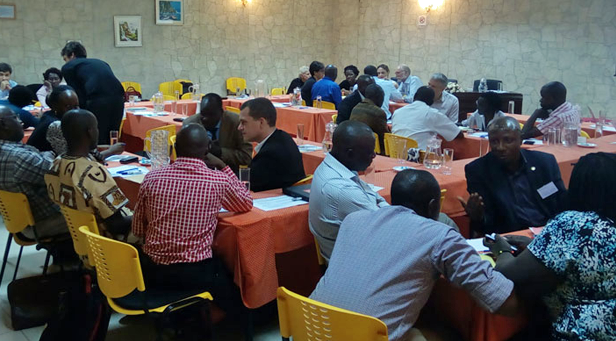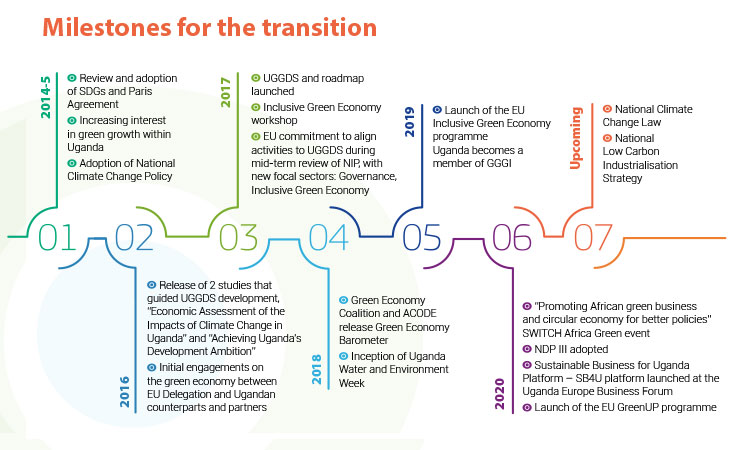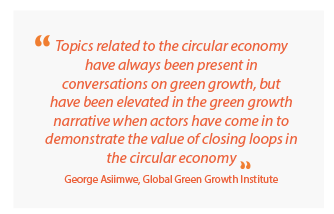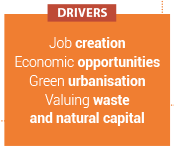Uganda goes green and circular
Uganda is endowed with significant natural resources – including fertile soil, oil, reserves of minerals and reserves of critical metals such as cobalt and rare earth elements. Natural capital is vital for the country’s development, being the backbone of a flourishing agriculture, tourism industry and related value chains. Sustainable development is, however, challenged by increasing pressures from a rapidly growing and urbanising population. The annual population growth rate of 3% (one of the world’s highest) and associated growing agricultural needs, are among the key factors contributing to deforestation, soil erosion and reduced wetlands cover. 700,000 young people enter the work force every year with bleak employment
prospects, often having to work in subsistence agriculture, further impacting the environment and leaving their livelihoods prone to climatic shocks.
The elaboration of the country’s Vision 2040, provided the foundations (as early as 2007) for a “green economy and clean environment where the ecosystem is sustainably managed and the liveability of the urban systems is greatly improved”. A few years later, when integrating the SDGs into the Second National Development Plan (NDP II) 2015/16-2019/20, the Government took significant steps towards green growth, including the adoption of a National Climate Change Policy (2015).
Two studies, on the “Economic Assessment of the Impacts of Climate Change in Uganda” (2016) and on “Achieving Uganda’s Development Ambition” (2016), guided the development of the Uganda Green Growth Development Strategy (UGGDS). A consultative process led by a multi-sector National Task Force prepared the UGGDS (2017) and complementing Roadmap, focusing on five areas of investment: agriculture, natural capital management, green cities (urban development), transport,
and energy. Sector-specific strategies and policies, such as the Sustainable Energy 4 All action agenda 2015-2030, and Nationally Appropriate Mitigation Actions, further supported the green economy transition. Relevant ongoing policy processes also include the National Climate Change Law. Discussions on the green growth agenda in Uganda have been increasingly influenced by the circular economy (CE) transition narrative. Ministries from various sectors have progressively acknowledged the benefits of valuing waste as a resource, for example through bringing in circularity considerations to landfill design. The private sector has shown a growing interest in CE investments. This interest has particularly focused on industrialisation and urbanisation, as reflected in the Third National Development Plan (NDP III) 2020-2025, and is expected to be integrated into the National Low Carbon Industrialisation Strategy 2020-2040.
How the EU supports a just transition to a greener
and more circular economy
As Uganda’s interest in green growth developed, the EU Delegation to Uganda underwent a similar process. Following pilot actions, the EU Delegation shifted the focal sectors of the National Indicative Programme to (1) Governance, and (2) Inclusive Green Economy.
The External Investment Plan in 2017 offered opportunities to build a programme that linked public and private sector actions. The EU Delegation aimed to further develop green economy awareness and capacities both in-house (EU Delegation staff) and in partner organisations in Uganda, with an inspirational, learning and networking event, the Inclusive Green Economy Workshop (2017). The workshop brought together representatives from the EU, international organisations, the national and local governments, the private sector, civil society, and financial institutions.
The Inclusive Green Economy focal sector comprises EU projects on access to energy, inclusive green city planning, and access to finance. In compiling actions, the EU Delegation to Uganda was able to build on existing projects that contribute to green and inclusive economy objectives, address the environmental and social impacts of ongoing projects, and engage with other development partners. Many programme components have therefore been co-financed with financing from other actors. The EUD funds the “Inclusive Green Economy Uptake Programme (GreenUP)”. The programme looks at making Uganda’s policy and regulatory framework conducive to private sector involvements in the green and circular economy. It addresses Uganda’s business environment, investment climate, and value chain development. More recently, frameworks taken into consideration by the EU
Delegation to Uganda when developing the Inclusive Green Economy programmes have included the European Green Deal roadmap and the EU Taxonomy for sustainable investment. In March 2020, the first ever Uganda-Europe Business Forum (3/2020) was conducted with EU support. At the forum the Sustainable Business for Uganda Platform (SB4U) was launched
with a view to facilitating a structured dialogue between investors
and the private sector.
DOWNLOAD the complete case study
- Supporting the action “Promoting Inclusive Green Economy in Uganda”
Conducting the Uganda Inclusive Green Economy Workshop
Supporting projects on access to energy, inclusive green cities planning, and access to finance
Support to the Uganda Europe Business Forum and the Sustainable Business for Uganda Platform – SB4U
Supporting the EU action “Inclusive Green Economy Uptake Programme (GreenUP).”
Supporting research and advocacy for an Inclusive Green Economy under the Green Economy Dialogues project

Rely on partners
who are active in the inclusive green and circular economy to help map the sector. The EU Delegation to Uganda navigated the complexity of the green economy environment by leveraging the experience of partners in the identification of options for potential programme components, and by viewing the just transition as an ongoing process.
Use the topic of access to finance
to promote synergies across programme components. Leverage private
sector financing is quite a new approach, and can address challenges seen in multiple sectors. Green and circular economy projects can benefit from both blended finance operations, and technical assistance (or other support) to local banks, resulting in improved access to finance to MSMEs across value chains.
Start cooperation on the green and circular economy
even before having established a strictly defined terminology for relevant actions or a shared understanding of the terms among stakeholders. A broad understanding of the processes involved, that encompasses multiple types of projects, is sufficient to get started. A more detailed operational agenda can be subsequently developed, as a clearer definition of the transition becomes broadly accepted.
Shifting the focus
on a green and more circular economy takes time, and should
be seen as an ongoing process. It takes time for awareness to evolve and for social progress in factors such as education and equality to create the conditions necessary for engagement of the population and the private sector. It also takes time to make appropriate implementation arrangements.



